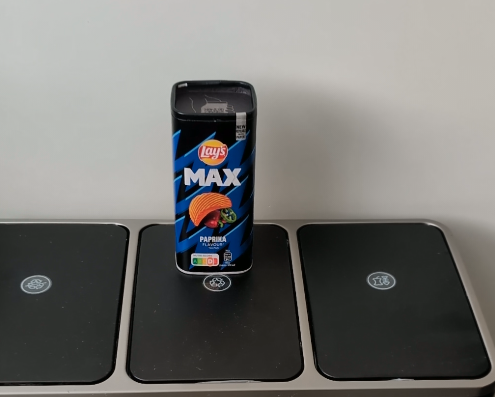At first glance, it seems like an improvement: where chips used to come in shiny plastic bags with an aluminum lining, Lay’s has now introduced a new tube. The outside is made of cardboard — proudly stated on the front of the packaging. Their website even claims the packaging can go in the paper bin. The inside, however, still gleams like foil. It feels… more sustainable? Greener? As if you’re doing the right thing by neatly tossing it in the paper or recycling bin.
But is that feeling justified?
The front reads “New recyclable with paper.” So what does that actually mean?
It creates the illusion that it’s easier to recycle — and that’s exactly where it goes wrong. This new cardboard chip tube is not recyclable. In fact, in several ways, the new packaging creates more waste, more confusion, and bigger problems in public spaces. Here’s why.
Why can’t this tube go with the paper?
The new packaging consists of multiple layers firmly glued together: cardboard on the outside, silver foil on the inside, and a thin plastic layer in between. The bottom is made from solid cardboard to keep the tube sealed.
For recycling purposes, multi-layer packaging is a nightmare. These layers can’t be separated effectively with current paper or plastic processing methods. Paper mills can’t use it, and if you throw it in the plastic bin (or Recycling bin), it contaminates that stream too. In the end, there’s only one correct destination for this packaging: residual waste.
Lay’s own website even states:
“Finished your SnackBox? Follow these steps to recycle it.”
“Snackbox and lid: dispose of in the paper bin.”
That advice is not just confusing — it’s flat-out incorrect.
But wait — didn’t the old chip bag go in the recycling bin?
Correct. The classic chip bag is made of plastic and aluminum — not yet recyclable with current technology. But there’s one big difference: the chip bag is allowed in the recycling bin so that in the future, it becomes cost-effective to recycle.
Where the chip tube looks like a sustainable cardboard container, the old chip bag clearly looks like plastic. Nobody assumes that belongs in the paper bin. The new tube, however, creates confusion and will likely be thrown in the wrong bin — despite good intentions.
What’s more: the tube is heavier, bulkier, and harder to store than the old bag. And that matters — in many municipalities, you now pay for your residual waste. One SnackBox can already take up a large chunk of your bin space.
What does this mean for litter?
Let’s be clear: no packaging belongs in nature. But even here, the new chip tube performs worse.
A flat chip bag might blow away but is easy to pick up. The tube is large, stiff, and awkward — it’s harder to move, harder to hide, and far more visible in the streetscape. Lay’s markets the SnackBox as “convenient for on the go” — but is it easy to carry when it’s empty?
A wet tube also tears easily, leaving behind more scattered waste: soggy cardboard, bits of foil, and a plastic liner. Instead of a single empty bag, you’re now left with a confetti bomb of trash. And no one is happy about that — not the volunteers or the cities who end up cleaning it up.
What about CO₂ emissions?
There is one upside: the new packaging contains less fossil plastic. The cardboard comes from renewable sources, meaning a slightly lower CO₂ footprint in production.
But even that benefit is minimal.
Once the packaging ends up in the trash, that small gain is erased. Transport, incineration, and increased material volume all make the new packaging worse. So while it sounds more eco-friendly in theory, the actual impact is small — or even negative.
Don’t Be Fooled by Cardboard
The Lay’s chip tube is a perfect example of how packaging can look greener than it is. It’s a case of “light greenwashing” — no direct lie, but a strong suggestion of sustainability that doesn’t match reality. And that leads to confusion, incorrectly sorted waste, and more litter — especially since the packaging is hard to flatten and carry back home.
What Can We Do?
Chances are, this chip tube will end up in the paper bin far too often. Unless you scan it with the EcoScan app.
With EcoScan, you don’t need to be an expert. Just take a photo or scan the barcode, and we’ll tell you exactly where it belongs. Plus, you earn EcoCoins and can win great prizes with our Recycle & Win Challenge!
👉 Download the app now and start scanning your waste.
What Can Municipalities Do?
The new Lay’s chip tube clearly shows how packaging innovation without clear guidance leads to unintended consequences.
For municipalities, this means:
❌ More mis-sorting = higher processing costs
❌ More litter = higher cleaning costs
❌ Less trust = worse recycling behavior
With EcoScan, you give residents real-time sorting advice — right at the moment of disposal. That makes long-term sustainable behavior finally achievable.
Curious how EcoScan can support your city?
Visit this page for more information.

